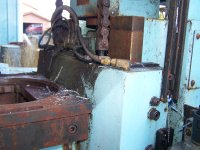jakefreese
Hot Rolled
- Joined
- Aug 4, 2012
- Location
- TEXAS
I am in the process of rebuilding the spindle in my 1992 blue Hurco BMC-30 Is there anyone here with experience this deep into the machine ?
The upper set of lower spindle bearings has checked out on me. Its got a bunch of hours on it, it did not get crashed, and it gets babied. I found replacement bearings which are on the way.
I was a bit shocked at the price of the belleville washers from Hurco $5 ea and there are 128 of them. They were stacked 2 high then 2 inverted so they were in packs of 4. I found some at McMaster that measure the dimensions and have #1388 lbs working load and #1810 lbs flat. I do not have a way to measure the force of the washers I currently have and do not know what the retention force was before it was taken apart this is a CAT40 spindle. I might buy a strain gauge to measure the existing ones to get an idea.
Next thing is bearing preload on both the lower set of bearings and the upper. Do any of you have an idea what the bearing preload should be ? The lowers are 2 pairs of 7014 bearings and the upper is a single pair of 7012. All 3 sets had thrust pointing at each other. Grease is the next question, this had a white soapy feeling grease in the bearings. A CNC tech told me what it more than likely was and I forgot. What is a reccomended grease for these now days ?
Last thing is the drive dog on the end of the spindle, there is some wear on it. What is considered the replacement point on these ? I need to see if I can buy it or if it will have to be made.
I am planning on monitoring 3 axis vibration and temperature during the break-in to see if a balance job needs to be performed on it, and also double check the spindle taper while it is out. The machine went from happy and and cutting nicely to angry and looking like things were cut with a chisel quickly and in the process it was eating the polymide bearing cage.
Thanks in advance everyone!
The upper set of lower spindle bearings has checked out on me. Its got a bunch of hours on it, it did not get crashed, and it gets babied. I found replacement bearings which are on the way.
I was a bit shocked at the price of the belleville washers from Hurco $5 ea and there are 128 of them. They were stacked 2 high then 2 inverted so they were in packs of 4. I found some at McMaster that measure the dimensions and have #1388 lbs working load and #1810 lbs flat. I do not have a way to measure the force of the washers I currently have and do not know what the retention force was before it was taken apart this is a CAT40 spindle. I might buy a strain gauge to measure the existing ones to get an idea.
Next thing is bearing preload on both the lower set of bearings and the upper. Do any of you have an idea what the bearing preload should be ? The lowers are 2 pairs of 7014 bearings and the upper is a single pair of 7012. All 3 sets had thrust pointing at each other. Grease is the next question, this had a white soapy feeling grease in the bearings. A CNC tech told me what it more than likely was and I forgot. What is a reccomended grease for these now days ?
Last thing is the drive dog on the end of the spindle, there is some wear on it. What is considered the replacement point on these ? I need to see if I can buy it or if it will have to be made.
I am planning on monitoring 3 axis vibration and temperature during the break-in to see if a balance job needs to be performed on it, and also double check the spindle taper while it is out. The machine went from happy and and cutting nicely to angry and looking like things were cut with a chisel quickly and in the process it was eating the polymide bearing cage.
Thanks in advance everyone!











